The Northrop F-5 Freedom Fighter
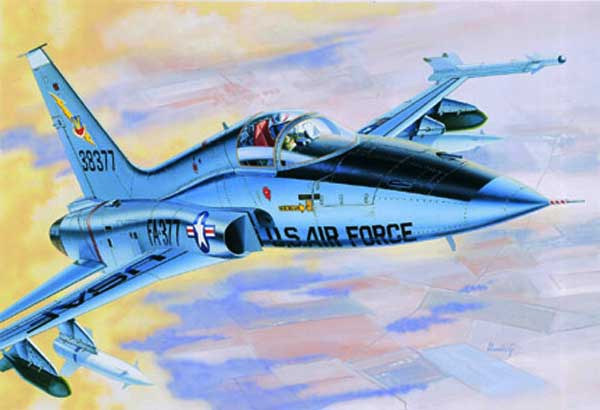
The F-5 is a supersonic fighter combining low cost, ease of mai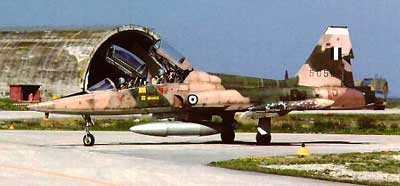 ntenance, and great versatility. More than 2,000 F-5 aircraft have been procured by the USAF for use by allied nations. The F-5, which resembles the USAF Northrop T-38 trainer, is suitable for various types of ground-support and aerial intercept missions, including those which would have to be conducted from sod fields in combat areas.
ntenance, and great versatility. More than 2,000 F-5 aircraft have been procured by the USAF for use by allied nations. The F-5, which resembles the USAF Northrop T-38 trainer, is suitable for various types of ground-support and aerial intercept missions, including those which would have to be conducted from sod fields in combat areas.
The F-5 first flew at the end of July, 1959 and deliveries to the Tactical Air Command for instructing foreign pilots began in April 1964. Pilots from Iran and South Korea the first to be trained in the F-5, followed by pilots from Norway, Greece, Taiwan, Spain, and other Free World nations which have adopted the F-5. A two place combat trainer version, the F-5B, first flew in February 1964. In 1966-67, a USAF squadron of F-5s flew combat missions in Southeast Asia for operational evaluation purposes.
Northrop F-5 Freedom Fighter
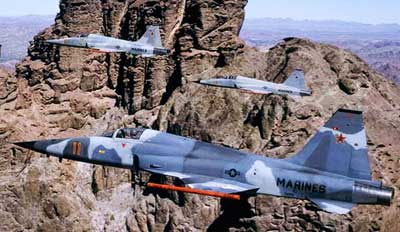
Although all F-5A production was intended for MAP, the Air Force actually requested at least 200 F-5s for use in Vietnam. This sudden request on the part of the USAF -- which had previously perceived no need for a lightweight fighter -- was a result of heavier than expected attrition in Southeast Asia and because the F-5 promised to be available with a relatively short lead time. The single-seater was to have been designated F-5C, the two-seater F-5D.
This request was initially turned down by the Defense Department, but a USAF request for combat evaluation in Southeast Asia was approved by the DoD in July of 1965, and the evaluation was initiated on July 26, 1965.
The program was given the code name Sukoshi Tiger, which was a corruption of "Sukoshi Tiger" (Japanese for "Little Tiger"). In October 1965, the USAF "borrowed" 12 combat-ready F-5As from MAP supplies (5 F-5A-15s and seven F-5A-20s) and turned them over to the 4503rd Tactical Fighter Wing for operational service trials. The 4503rd TFS (Provisional) was formed on July 29, 1965 to conduct the evaluation, and their pilots underwent training at Williams AFB while Northrop modified the aircraft for duty in Southeast Asia.
The aircraft were modified to have in flight refueling probes on the port sides of their noses, 90 pounds of armor plate on their bellies, and jettisonable pylons underneath their wings. Instruments and flight controls were modified and the standard Norsight fixed optical sight was replaced by a lead-computing gun sight. The rudder travel limiter was removed, and the aircraft were camouflaged in tan and two-tone green, with light gray undersides. They were redesignated F-5C for their service with the USAF.
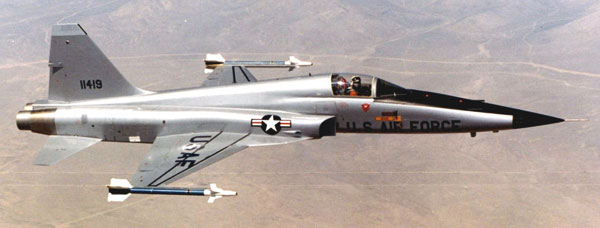
The aircraft left Williams AFB on October 20, 1965 for Southeast Asia, arriving at Bien Hoa on October 23. They flew their first combat mission the same afternoon. In four months, the F-5As flew 2500 hours of close support, interception, and reconnaissance missions. Later, six more F-5As arrived, bringing up the strength to 18. In March of 1966, the 4503rd lost its provisional status and became the 10th Fighter Commando Squadron attached to the 3rd TFW at Bien Hoa.
More than 4000 combat hours were logged in over 3500 combat sorties for the loss of two aircraft. Typical combat loads were 2000-3000 pounds. The F-5 missions were exclusively over the South, and they never crossed the North Vietnamese border because their arrival coincided with a lull in the offensive against the North. The aircraft never encountered enemy MiG's, and so never got a chance to demonstrate their air-to-air capabilities.
As compared to other aircraft, the bomb aiming and delivery system of the F-5 was relatively unsophisticated. Most weapons deliveries were made from a shallow dive, with the pilot judging the range by using his lead computing gun sight. A 150-gallon drop tank was usually carried on the centerline pylon, with an additional 150-gallon tank being carried on each of the inboard underwing pylons.
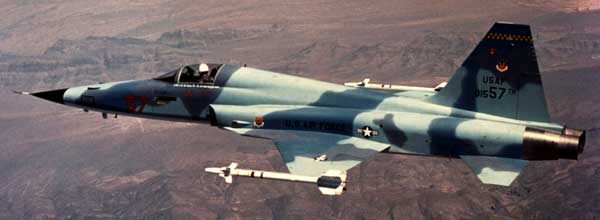
Although the load-carrying capability of the F-5 was not as great as that of other types such as the F-4 Phantom and the F-105 Thunder chief, the Northrop fighter was fast and agile, making it ideal for dodging ground fire during attack runs. It actually proved to be the least vulnerable jet aircraft in the war zone.
On the debit side, the takeoff roll of a heavily-laden F-5
was excessively long, and the range was considered to be inadequate.
Difficulties were encountered with the dropping of 750-pound napalm tanks, which sometimes failed
to separate cleanly, striking the underside of the wing. The guns
of the F-5 tended to "smoke up" the windshield during firing runs, particularly
in rainy conditions. Sometimes, rounds bursting just ahead of
the nose would damage the windshield, and gun gases ingested into the intake sometimes resulted
in engine damage. These problems were solved by USAF ground crews,
acting in cooperation with Northrop representatives. The F-5 ultimately
achieved the lowest maintenance time per flight hour of any aircraft
operating in the
Vietnamese theatre.
Although the Freedom Fighter was judged to be a technical success in Vietnam, the Skoshi Tiger program was essentially a political project, designed to appease those few Air Force officers who believed in the aircraft. The Freedom Fighter was destined to have a relatively brief operational career with the USAF, and the DoD turned down a second request for F-5s, deciding instead to look at other types such as the A-7 Corsair II. The 10th Fighter Commando Squadron was soon disbanded, and the surviving F-5s were turned over to the South Vietnamese Air Force.
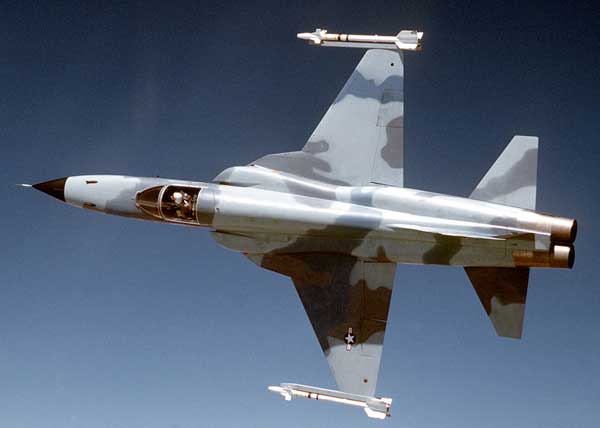
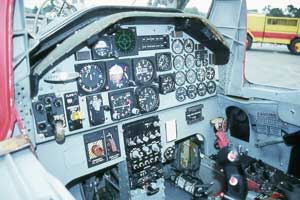 |
The Cockpit of the Northrop F-5 Freedom Fighter. |
Specifications
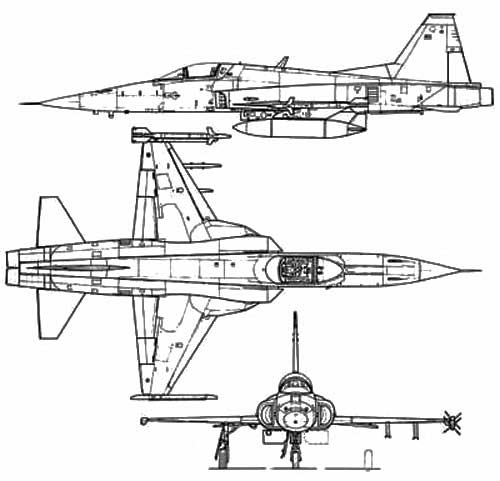 |
Length: 47 ft 4.75 in |
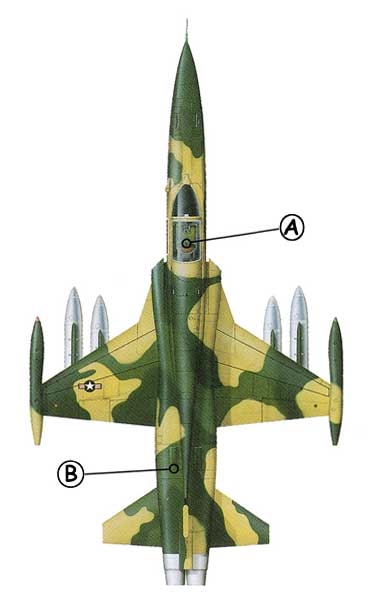 |
|
| A: Serving over Vietnam between October 1965 and April 1967, the USAF Skoshi Tigers flew 9,985 missions, in which nine aircraft were lost, Around 17,000 general-purpose bombs had been dropped. | B: F-5Cs were powered by two afterburning General Electric J85 turbojets. For low-speed operations, air louvre doors on the rear fuselage provided improved air flow. |
 |
|||
| A: Mounted in the nose are two 20-mm M39A2 lightweight cannon, with 280 rounds of ammunition. A nose-mounted refueling probe and night formation lights were also added to USAF Freedom Fighters. | B: The F-S's cockpit afforded good pilot visibility. Seated on a rocket-powered ejection seat, USAF Freedom Fighter pilots over Vietnam were fortunate that their aircraft had an additional 200 lb of cockpit and engine armour. | C: Skoshi Tiger aircraft typically carried mission markings. Flying up to four times a day, the 10th FCS was kept busy on light attack duties. | D: Underwing, on jettisonable pylons specifically fitted for Vietnam service, the F-5C carried up to 6000 lb of rockets, gun pods, bombs or, as shown here, four 750 -lb BLU-1 anti-personnel napalm tanks. |
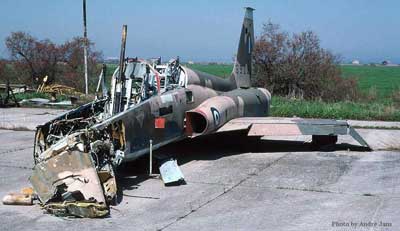 |
"I shot this around April 1999. Mach III book mentiones W/o 13-7-1993. I am not aware of the circumstances
but surely the frontseater ejected above the airfield of Thessaloniki-Mikra AB." Photo by Andre Jans |

